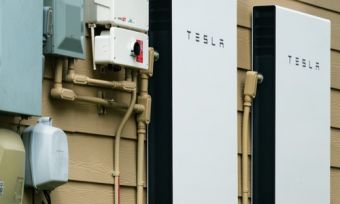Best Solar Feed In Tariff VIC
Looking for a better solar plan or provider in Melbourne? We compare plans and providers that operate in and around the Melbourne area to help you find the best fit for your needs.

Start with your postcode
to compare 1,500+ Canstar Blue expert rated plans
Showing 10 of 85 results
Unsure of a term in the above table? View glossary
The initial results in the table above are sorted by Solar feed-in tariff (High-Low) , then Price/year (estimated) including conditional discount (Low-High) , then Brand Satisfaction (High-Low) . Additional filters may have been applied, which impact the results displayed in the table - filters can be applied or removed at any time.
Latest in solar energy
There are so many reasons to install solar panels in Victoria, but most people just want to know how much they’ll be able to save on energy bills. Despite a plethora of contributing factors to any potential savings, it’s the feed-in tariff (FiT) that draws the most attention.
This figure dictates how much of a credit households will receive on their power bills for exporting leftover electricity back into the grid. But is it as simple as just signing up to the solar plan with the highest FiT? Often there are more factors at play that impact the overall price Victorians pay for power. With this in mind, let’s take a peek at the best solar feed-in tariffs in Victoria, as well as some other features to look out for to help maximise returns on your solar investment.
On this page:
- Which provider has the best solar feed-in tariff in VIC?
- Best solar feed-in tariffs in VIC
- Which is the best solar energy provider?
- How do I know what my solar feed-in tariff is?
- Is there a minimum feed-in tariff in VIC?
- Are there solar-specific plans available in VIC?
- Feed-in tariffs vs energy rates: What’s more important?
- Is solar worth it in VIC?
Which provider has the best solar feed-in tariff in Victoria?
Engie currently offers the best solar feed-in tariffs (FiTs) in Victoria at the time of publication, with eligible customers receiving 12 cents per kilowatt hour (c/kWh) of energy exported to the grid. Following this is EnergyAustralia with 12c/kWh and Alinta Energy with 10c/kWh. Note that the Victorian energy regulator has set a minimum FiT rate of 3.3c/kWh for solar customers on a single rate tariff.
The best minimum and maximum solar feed-in tariffs in VIC
In the table below, you’ll find a list of minimum and maximum solar feed-in tariffs available from retailers in Victoria. Some of these companies may not operate in all areas of VIC, while some FiTs may only be available when certain conditions are satisfied. Please check each provider’s website for further details.
Here are the plans with the highest solar feed-in tariffs from the retailers on our database. These costs are based on the Citipower network in Melbourne but prices will vary depending on your circumstances. We show one product per retailer, listed in order of lowest price first. Annual price estimates assume general energy usage of 4000kWh/year for a residential customer on a single rate tariff. Price estimates exclude solar feed-in tariff credits. Our database may not cover all deals in your area, please check retailer websites for up to date information.
Here are the plans with the lowest solar feed-in tariffs from the retailers on our database. These costs are based on the Citipower network in Melbourne but prices will vary depending on your circumstances. We show one product per retailer, listed in order of lowest price first. Annual price estimates assume general energy usage of 4000kWh/year for a residential customer on a single rate tariff. Price estimates exclude solar feed-in tariff credits. Our database may not cover all deals in your area, please check retailer websites for up to date information.
Which is the best solar energy provider?
Red Energy is currently ranked as Australia’s best solar energy provider, according to Canstar Blue’s 2024 customer satisfaction ratings. The Australian-owned energy company snagged five stars for its customer service, bill and cost clarity, ease of sign-up and overall satisfaction. While Red Energy doesn’t have solar specific plans in Victoria, its standard market offers in the state come with feed-in tariffs.
How do I know what my solar feed-in tariff is?
The feed-in tariff rate you receive from your retailer should be listed on your plan’s energy fact sheets. These are documents that all energy providers must list on their website, however some can be trickier to find than others. Energy fact sheets are usually located on the bottom of a retailer’s website and will normally list each plan’s solar feed-in tariff.
Is there a minimum feed-in tariff in VIC?
Customers in Victoria can find some level of comfort in the fact that there is currently a mandated minimum solar feed-in tariff rate of 3.3c/kWh for customers on single rate tariffs. However, is a large decrease from previous years where solar customers received 10.2c-12c/kWh.
Are there solar-specific plans available in VIC?
Yes, there are a handful of retailers who offer plans marketed to customers with solar panels, however some power companies may not always have them publicly listed. This means it’s best to check directly with the provider. While a solar-specific plan sounds good on paper, you’ll need to double check that the electricity rates have not been increased to cover a higher feed-in tariff.
Feed-in tariffs vs energy rates: What’s more important?
Sometimes energy providers hide increased electricity rates behind a large solar feed-in tariff, which can be confusing to say the least. The base rates of an energy plan should still be price competitive, regardless of how high the FiT is, but it will ultimately come down to your personal circumstances and household needs.
A house that exports plenty of excess power to the grid may benefit from a higher feed-in tariff, which in turn could justify paying higher electricity usage and supply rates. On the other end of the spectrum, a household with smaller solar capabilities may be better off with an average FiT and lower base rates. You should crunch the numbers to see how much money you’re saving off power bills and work out if cheaper rates could benefit your back pocket, or a bigger feed-in tariff rate.
Is solar worth it in VIC?
Solar is a huge investment, costing upwards of thousands of dollars, and that’s before you even have it installed. With such a hefty upfront cost, finding a good deal that can pay itself off over time will help you get the most from your solar system.
With a little bit of homework and understanding of which features are important to you, there are plenty of savings to be made, especially if you can cash in on a solar rebate.
About our electricity experts
 Tara Donnelly: Utilities Editor
Tara Donnelly: Utilities Editor
As Canstar Blue’s Utilities Editor, Tara Donnelly covers the internet, mobile and energy sectors – topics she’s spent a decade focused on, alongside consumer technology, within the comparison industry. Her telco expertise has seen her appear in national media including 9 News, 7 News, Sunrise, the ABC and The Sydney Morning Herald. You can follow Tara on LinkedIn.
Meet the Editorial Team

Breanna Gream: Data Insights Team Lead
Breanna Gream is Canstar’s Data Insights Team Lead, and is responsible for developing the methodology and delivering Canstar Blue’s Value Ranking for the energy and telco sectors. She holds a dual degree in Business and Mathematics from the Queensland University of Technology, and enjoys using her skills to help consumers find more suitable utilities plans. Connect with Breanna on LinkedIn.
Meet the Research Team
Important information
For those that love the detail
This advice is general and has not taken into account your objectives, financial situation or needs. Consider whether this advice is right for you.





















